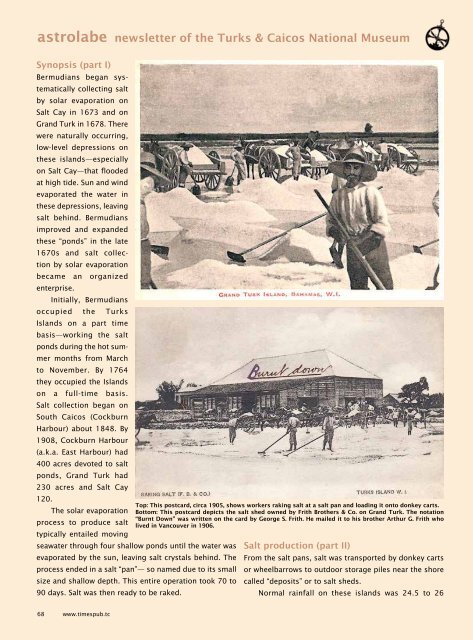Times of the Islands Summer 2022
Presents the "soul of the Turks & Caicos Islands" with in-depth features about local people, culture, history, environment, real estate, businesses, resorts, restaurants and activities.
Presents the "soul of the Turks & Caicos Islands" with in-depth features about local people, culture, history, environment, real estate, businesses, resorts, restaurants and activities.
Create successful ePaper yourself
Turn your PDF publications into a flip-book with our unique Google optimized e-Paper software.
astrolabe newsletter <strong>of</strong> <strong>the</strong> Turks & Caicos National Museum<br />
Synopsis (part I)<br />
Bermudians began systematically<br />
collecting salt<br />
by solar evaporation on<br />
Salt Cay in 1673 and on<br />
Grand Turk in 1678. There<br />
were naturally occurring,<br />
low-level depressions on<br />
<strong>the</strong>se islands—especially<br />
on Salt Cay—that flooded<br />
at high tide. Sun and wind<br />
evaporated <strong>the</strong> water in<br />
<strong>the</strong>se depressions, leaving<br />
salt behind. Bermudians<br />
improved and expanded<br />
<strong>the</strong>se “ponds” in <strong>the</strong> late<br />
1670s and salt collection<br />
by solar evaporation<br />
became an organized<br />
enterprise.<br />
Initially, Bermudians<br />
occupied <strong>the</strong> Turks<br />
<strong>Islands</strong> on a part time<br />
basis—working <strong>the</strong> salt<br />
ponds during <strong>the</strong> hot summer<br />
months from March<br />
to November. By 1764<br />
<strong>the</strong>y occupied <strong>the</strong> <strong>Islands</strong><br />
on a full-time basis.<br />
Salt collection began on<br />
South Caicos (Cockburn<br />
Harbour) about 1848. By<br />
1908, Cockburn Harbour<br />
(a.k.a. East Harbour) had<br />
400 acres devoted to salt<br />
ponds, Grand Turk had<br />
230 acres and Salt Cay<br />
120.<br />
The solar evaporation<br />
process to produce salt<br />
typically entailed moving<br />
seawater through four shallow ponds until <strong>the</strong> water was<br />
evaporated by <strong>the</strong> sun, leaving salt crystals behind. The<br />
process ended in a salt “pan”— so named due to its small<br />
size and shallow depth. This entire operation took 70 to<br />
90 days. Salt was <strong>the</strong>n ready to be raked.<br />
Top: This postcard, circa 1905, shows workers raking salt at a salt pan and loading it onto donkey carts.<br />
Bottom: This postcard depicts <strong>the</strong> salt shed owned by Frith Bro<strong>the</strong>rs & Co. on Grand Turk. The notation<br />
“Burnt Down” was written on <strong>the</strong> card by George S. Frith. He mailed it to his bro<strong>the</strong>r Arthur G. Frith who<br />
lived in Vancouver in 1906.<br />
Salt production (part II)<br />
From <strong>the</strong> salt pans, salt was transported by donkey carts<br />
or wheelbarrows to outdoor storage piles near <strong>the</strong> shore<br />
called “deposits” or to salt sheds.<br />
Normal rainfall on <strong>the</strong>se islands was 24.5 to 26<br />
68 www.timespub.tc
















